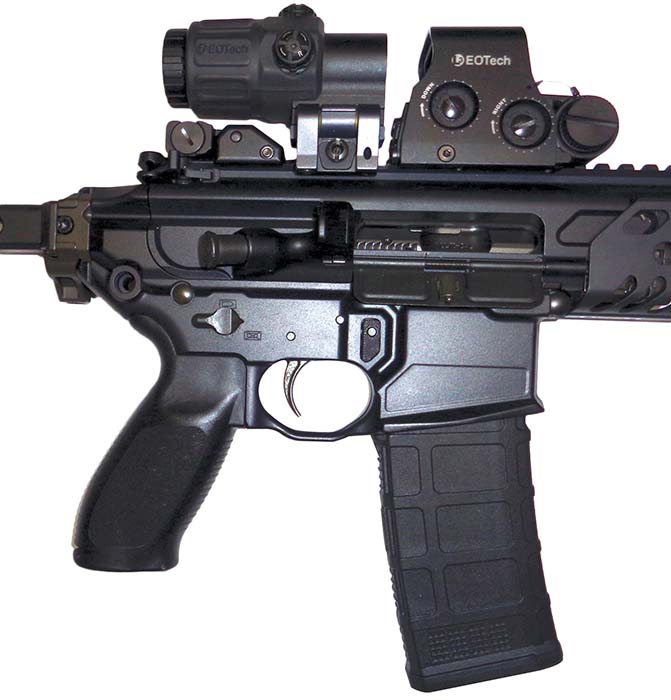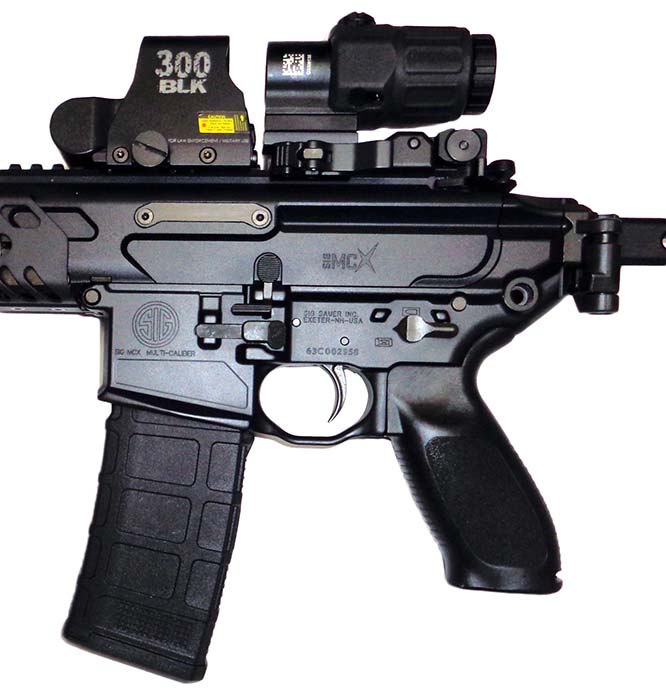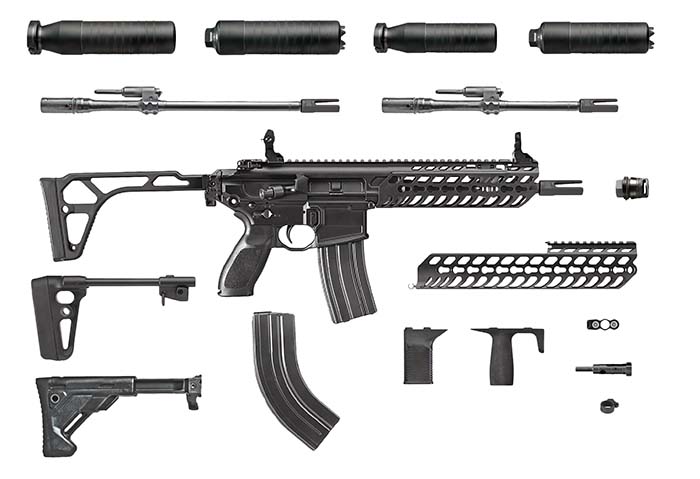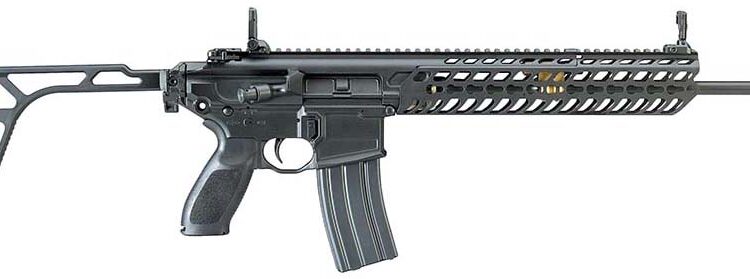By Christopher R. Bartocci
The trend of external piston operated AR-type rifles seems to be in a descending period. They do not appear to have the flair they did 10 years ago. The AR-type rifle was not designed for this operating system. It was designed as an in-line construction, direct gas impingement rifle. The main difference is how the gas is introduced. The AR-family was designed to have the gas directed into the bolt carrier where the piston chamber is made up between the back of the bolt and back of the carrier giving it a perfectly centered drive rearward. When utilizing an external piston the bottom of the rear location of the carrier is tilted downward when it enters the receiver extension due to the off center strike of the operating rod on the top of the bolt carrier, creating the common “carrier tilt” issues. Other issues include the receiver damage of the cam locking cut inside the upper receiver where the cam pin cuts into the receiver. The end result is adapting a weapon, which is not designed for that operating system, and the designer must develop solutions to overcome these new problems. If you want an external piston gun, why not design it that way?? The first true reconciliation of this problem was Robert Faxon with his ARAK-21. A complete redesign of the upper receiver that will fit on an AR lower receiver that eliminates all the problems of converting an AR upper to the wrong operating system! The receiver is a long stroke piston which has a bolt carrier that rides in rails in the upper receiver keeping it properly aligned so there are no carrier tilt issues, utilizing an internal action spring while maintaining the strong multi-locking lug bolt.

In 2012, Sig Sauer was approached by an undisclosed special operations unit with a requirement for a 300 Blackout rifle that would function with both sub and supersonic ammunition as well as when suppressed. According to Chris Sirois, then Design/Engineering lead on the program for Sig “The goals of the MCX program were set by the customer. There were several design review meetings with the customer to agree on design performance.” Yes, you heard all this correctly, the MCX was designed from the ground up to be chambered in 300 Blackout and then later adapted to 5.56x45mm. All design, research and development was done at the USA subsidiary in Exeter, New Hampshire. The first prototypes of the MCX were tested in late 2012.
The lower receiver of the rifle is very similar to that of an M4 carbine with several changes. The lower receiver is manufactured from a 7075 T6 aircraft grade aluminum forging. The magazine utilized for both 300 Blackout as well as 5.56x45mm it the standard GI M16/M4 aluminum magazine. According to Chris Sirois, they tested numerous magazines for reliability. They settled on the standard US GI magazine with second preference for the Lancer AWM magazines. The lower receiver is equipped with an ambidextrous magazine release. There is a magazine release button located right beneath the bolt catch on the left side of the receiver. The magazine release button on the right side is at least twice the size of a standard AR, making it much easier to actuate. The bolt catch is modified as well and easier to actuate. The lower portion is extended upward and .790 inches to the left making it easier to actuate with and without gloves. The safely/selector is ambidextrous and very high profile. This is one of the finest this author has seen, it is easily actuated with and without gloves. The right arm is held in place by a spring pin. The trigger group is standard AR-type mil-spec trigger group. This can be semi-auto only or select fire. The test and evaluation rifle is semi-automatic only. The trigger on this particular rifle was on the high end at 8 1/2 pounds. The trigger guard is oversized and part of the receiver. The pistol grip is an ergonomic Sig design used on many of their different rifles. There is a door on the base of the grip permitting storage. The rear of the receiver has quick detachable sling mount sockets on both the right and left sides. The magazine well is flared and beveled.

Due to the use of a recoil mechanism inside the upper receiver, there is no need for a receiver extension. The rear of the receiver is solid. On the back is a Mil-Std-1913 rail segment to which one of five stock options will attach. The standard stock is a side folding fixed stock (folds to left side). The second is a telescopic stock similar to that of the H&K MP5. This is a 3-position telescopic stock which is slightly shorter than the standard side folding stock. The rear of the stock has both right and left side quick-detachable sling mount sockets. There is also a sling swivel located on the face of the stock’s mount to the receiver. Sig also offers a proprietary side-folding telescopic stock as well as a telescopic Mil-Spec tube which will permit any standard stock to be installed. The last is a pistol stock which can be had with and without the Sig Brace.
The charging handle is proprietary to the MXC design. It is ambidextrous and easy to grab on either side. It is also made from 7075 T6 aircraft grade aluminum.
The upper receiver is quite interesting. The receiver is one piece and manufactured from an extrusion of 7075 T6 aircraft aluminum. There are several unique features. The receiver does have a forward assist and a fired cartridge case deflector as well as an ejection port dust cover. Inside of the receiver are two rails that the bolt carrier group rides on which keep it centered when the bolt moves rearward, similar to that of an AK. This is normal in any external piston operated rifle such as the AK, FAL, H&K G36 and AR18 to just name a few. Added to the receiver is a steel reinforced cam path guard which keeps the cam pin from damaging the receiver. The top rail is continuous. There are both long and short aluminum handguards that slide along a rail in the top rail on the receiver. The handguard is locked in place by a tab that slides into a slot on the upper receiver and is held in place by the front pivot pin.
Most importantly, the upper receiver has a quick change barrel option. By loosening two T27 Torx screws, the two barrel clamps (screws are captive), the barrel assembly is pulled from the receiver. The barrels all have an adjustable gas valve which permits normal and suppressed settings. There is an open slot in the end of the rail on the upper receiver permitting easy access to this tilting valve.

The barrel is easily changed out at the user level with only the need for a torque wrench (60 in lbs). As of this writing the 300 Blackout is offered in 9- and 16-inches in length (1/6 twist, RH). The 5.56x45mm is available in 11.5- and 16-inches (1/6 twist, RH) and the 7.62x39mm is available in 11.5- and 16-inches (1/9.5 twist, RH). For caliber conversion, the same bolt and same magazine are used for the 5.56x45mm and 300 Blackout calibers. The 7.62x39mm requires a new bolt and different magazine. All barrels are topped off with Sig’s proprietary three-prong flash suppressor that will fit any of Sig’s new sound suppressors. The barrel assembly consists of the barrel, barrel extension, gas block, piston, gas valve and flash suppressor. Unlike most current external piston designs, the MCX does not use any gas rings on the piston to seal up the expansion chamber. According to Chris Sirois “Because of the short barrel lengths and having to tap gas earlier on the barrel, the gasses are much hotter and pressures higher and gas rings could not withstand much firing. We had to develop a ringless system which in the end created a much more durable gas system.”
The bolt carrier group consists of the bolt carrier, bolt assembly, operating rod, two spring rods, spring guide, spring plate, cam pin, firing pin and firing pin retainer pin. Looking at the bolt you would think it was proprietary but it is not, it is a standard AR15 bolt. The one provided has the rear turned down due to it not needing gas rings. If you need a quick replacement, you can put any mil spec bolt in and it will work properly. The two recoil springs are good for all three calibers the rifle is chambered for. The bolt carrier group is disassembled without any special tools. The spring guides pop out from the spring plate, they are lifted out of the slot in the plate. Then the recoil springs are slid out. The rods are then pulled out through the spring guide. Then the bolt disassembles like a standard AR15. Slide out the firing pin retainer pin, drop the firing pin out from the back of the carrier and then rotate the cam pin 1/4 turn and lift out of the bolt carrier. The bolt is then pulled out the front of the carrier. With the firing pin retainer pin, push the extractor pin inward to remove and then lift the extractor out of the bolt.

According to Chris Sirois, the MXC has approximately 40% parts commonality with the M4, which is important for customers who already may use the M4. It is far less of a logistical burden for parts. During the development Sig encountered two major issues. According to Chris Sirois “The two most challenging problems that we faced were finding the correct barrel twist rates to meet all accuracy requirements in all required bullet type and overcoming the bolt carrier bounce without the standard AR/M4 type buffer system”. The bolt carrier bounce is the real secret to the success of the MCX rifle. Few rifles out there chambered in the 300 Blackout cartridge will reliably cycle a subsonic round without a sound suppressor. The Sig MCX will. This is in why the gas port on the barrel is much closer than the standard carbine length gas system. The cyclic rate of the 5.56mm is around 800-950 rounds per minute with proper gas valve setting in both non suppressed and suppressed modes. The 300 Blackout cyclic rate ranged from 780 to 1100 rounds per minute. According to Chris Sirois “The requirement was to be able to run anything from subsonic unsuppressed to supersonic suppressed in either valve setting”.
The test and evaluation rifle was the Sig MCX Patrol rifle with a 5.56mm barrel. It came with a manual, 1 aluminum 30 round magazine, folding backup sights and magazine well block for safe storage. Ordered along with the rifle was the 300 Blackout conversion barrel. The barrel is all that is needed. The same magazine and bolt carrier group are used. A 7.62x39mm barrel was requested but was unavailable as of this writing. The fit and finish was superb which is what you would come to expect from Sig. It had the “AR” feel to it but it clearly was not.

Just about the time the rifle arrived, so did some of the new Sig Elite Performance Ammunition in 300 Blackout. These are a match grade ammunition. The first load is a supersonic load. It is a 125gr open tip match projectile with a muzzle velocity of 2200 feet per second and 1343 foot pounds of energy. The second load fired a 220gr open tip match projectile at 1000 feet per second muzzle velocity with 488 foot pounds of energy. There were three boxes of each fired. Along with that was Black Hills Ammunition 300 Blackout 125gr open tip match projectile with a muzzle velocity of 2200 feet per second and a muzzle energy of 1343 foot pounds. For the 5.56mm ammunition, 300 rounds of Black Hills Ammunition .223 Rem 55gr full metal jacket and 100 rounds of ZQI (Merkel) 5.56x45mm 62gr SS109 full metal jacket with steel penetrator core.
When firing the 300 Blackout, the EOTech Model 300™ Blackout was used. This is a non-magnified holographic sight specifically designated for the super and subsonic Blackout loads. The XPS2 offers a two dot ballistic drop reticle that allows the shooter to zero either subsonic or supersonic rounds in the same reticle pattern. There are two 1 MOA aiming dots. The top aiming dot, with a 16-inch barrel and 110gr supersonic round should be zeroed at 100 yards and the second dot will be point of aim at 300 yards. With a 16-inch barrel and 220gr subsonic round, the top dot should be zeroed at 50 yards and the second dot will be the point of aim at 150 yards. The sight is powered by a CR123 battery that has a 600 continuous hour life at nominal setting 12 at room temperature. The sight has an MSRP of $549. Also mounted to the rifle is an EOTech G33™ 3x magnifier mounted on a tilting mount. This has an MSRP of $589. For testing the 5.56mm barrel, an Elcan Specter DR 1x/4x was used. There is a lever with two positions, forward is 1x and rearward is 4x. This is a crystal clear mid range optic which is mounted with an ARMS throw lever mount.
First up was the 5.56x45mm variation. A total of 400 rounds were fired with no malfunctions of any sort. The range was limited to 50 yards due to some Texas flooding! At this limited range all groups were sub 1-inch. Both the Black Hills and ZQI ammunition were military grade ball rounds. The rifle was tested with various magazines for compatibility. These magazines included PMag, Lancer AWM, CProducts Defense steel, Hera, Hexmag, HK steel/plastic, ETS and D&H Tactical to name a few. There were no issues at all, the rifle functioned perfectly with all that was tested.
The barrel was swapped out to the 300 Blackout. A total of 380 rounds were fired with no malfunctions of any sort. GI aluminum, PMags and Lancer AWM, and a D&H Tactical 300 Blackout magazines were used. No feeding issues with any. There were 40 rounds of Sig Supersonic and 40 rounds of Sig Subsonic fired. The Supersonic was fired at 100 yards with an average group of 1 1/2 inches at 100 yards. The subsonic was fired at 50 yards and averaged just about an inch. Additionally there were 300 rounds of Black Hills Ammunition 300 Whisper 125gr OTM. This ammunition shot just over an inch at 50 yards. The rifle was placed in a Hyscore Black Gun ® Machine Rest. This took the human error out of it! I am sure this rest had a lot to do with the excellent performance of the rifle.
Also offered is an upgrade kit that may turn a standard AR15 lower receiver into a host for the MCX upper. The MCX upper receiver will just drop on any standard Mil-Spec lower receiver. You may even use your current stock assembly on the lower. However if you want to go to the side folding stock options designed for the MCK you may procure a adapter that fits onto the rear of the lower receiver which provides the Mil-Std-1913 rail needed to attach the MCX stock options.
The MCX has been adopted by U.K. Counter-Terrorism Police not to mention numerous other agencies and Special Forces units. The rifle is still rather new compared to its competition. It would be safe to say that the MCX is in a league all of its own. The stock modularity and barrel modularity make this perhaps one of the most mission adaptable assault rifles in the world. It has been heavily tested by Sig and is over-the-beach capable. The quality is second to none, what one would expect from Sig. Not to mention it is 100% American designed, tested and made right in Exeter, New Hampshire. The design team was made up of some of the finest engineers in the industry who have many years designing advanced military rifles. Sig has gone from primarily being known for handgun development to becoming an industry leader in advanced assault rifle and submachine development. Their MPX 9mm SMG is the most significant SMG since the MP5 but that is another story. The last few years have shown Sig diversifying their product line and will without a doubt be offering new and innovative updates to the MCX system and who knows what else!
| This article first appeared in Small Arms Review V20N7 (September 2016) |










